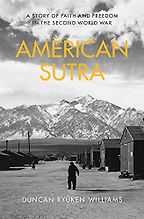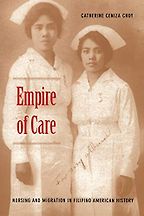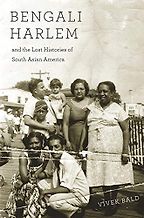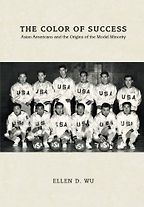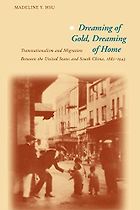The history of a panethnic group of Americans is our topic today. What ancestries are commonly included under the umbrella of Asian American history?
Asian American has always been a coalitional identity that changes as political needs and social circumstances change. The term Asian American developed in the late 1960s. Historically it has been centered on East Asian American experiences – the experiences of Chinese, Japanese and Korean Americans. In the seventies and eighties, the rubric of Asian American grew to include Southeast Asian refugees from Vietnam, Cambodia, and Laos. In recent decades, people from South Asia, India and Pakistan are included. The acronym APPI represents the most recent effort to add Pacific Islanders, people from Samoa and Guam.
But generally West Asian Americans are still considered a separate group, often referred to as Middle Eastern Americans. Why?
Coalition identities, like all political alliances, depend on context. There is a lot of utility in Arab Americans and Muslim Americans organizing alongside Asian Americans to achieve particular goals. I do think Arab Americans have had a distinctive racialized experience in the United States, based on their particular history and how the U.S. has engaged in the Middle East.
How Asian American is defined is an ongoing conversation. A decade ago, in the post-9/11 world, the Association for Asian American Studies made a conscious effort to include Muslims in the category because of their unfair treatment.
Turning to your books, please begin by telling me about Dreaming of Gold, Dreaming of Home by University of Texas at Austin professor Madeline Hsu.
I love this book because it upends how we think about immigration. It focuses on Chinese immigrants coming to the United States from Taishan, a region in southern China, and how they found ways to live lives that were very transnational. We tend to think about immigrants leaving one place and beginning their lives anew in the United States. We don’t take their pre-migration experiences seriously and we don’t consider how they continue to maintain connections with their home countries. This book is a really fantastic example of how Chinese immigrants led lives that spanned two continents and transformed lives back in Taishan by sending remittances back to China, while building lives in the United States. It’s a fantastic example of the overall trend in the study of immigration to think about migrants’ lives as not being bounded by the nation-state, but rather lived across national borders.
What push and pull factors led to the first big waves of immigration from China?
We need to think about the challenges they faced in China to understand why immigrants found the opportunities in the United States compelling. A number of circumstances—political conflict, economic troubles, the lack of available arable land—made life really difficult for people in this region of China at that time. In the United States, the discovery of gold and the promise of opportunity to prosper that it seemed to offer, drew immigrants. Even during exclusion, which began in the late 19th century, Chinese immigrants creatively circumvented the law and sent one family member to take advantage of opportunities in the United States to support relatives back in China.
Next, you’ve named American Sutra by USC professor and Sōtō Zen Buddhist priest Duncan Williams. This book reveals how, even as they were stripped of their homes and imprisoned in camps, Japanese American Buddhists launched one of the most inspiring defenses of religious freedom in our nation’s history, insisting that they could be both Buddhist and American. Please tell me about this book.
This is one of my favorite books ever, and it is pretty new. I don’t think we pay enough attention to the significance of religion in the construction of racial difference. That’s what Duncan Williams does in American Sutra. He highlights how Buddhist Japanese Americans had a pretty distinctive experience of being racialized and treated in a discriminatory way during the Second World War. He also highlights how there was a spiritual resilience that Japanese Americans displayed. Religion was a critical part of how they endured and survived.
The unique pressures on the religious practices of Asian immigrants to the United States is the subject of some of your work and your forthcoming book for Harvard University Press. Can you please tell me about that work?
I study Hmong refugees who came to the US in the seventies, eighties and nineties, after the war in Laos. American refugee policy made it very difficult for them to practice Hmong rituals in the US. Because families were separated and ethnic communities were dispersed, Hmong were deprived of the material resources and critical mass of community necessary to carry out their rituals. How America and Americans try to put ideals of religious pluralism in practice is a question at the center of my work.
“The idea that Asian Americans are all successful is a myth”
That’s why I’m really drawn to American Sutra, because it’s a question at the center of Duncan’s work, too. We’re a country of religious freedom and religious pluralism, but we don’t have a great record of upholding our commitment to those principles in practice. There is a long history of white Christian privilege in the United States. There’s a lot of attention to that issue in religious studies now. So I like that Duncan and a number of people have studied how religion plays a critical role in unequal relations of power.
I never considered the fact that America leaves refugee resettlement to non-profits and religious entities puts pressure on the practices of religions other than Christianity. Thank you for bringing that to my attention.
Empire of Care, by U Cal Berkeley Ethnic Studies professor Catherine Ceniza Choy, is your next recommendation.
This book is personal for me and it has been on my mind throughout the pandemic, which has hit Filipino American nurses particularly hard. My mom is Filipina and she came to the United States to work as a nurse. Part of the reason I like Empire of Care is that it is my family story.
But, also, it reminds us that we need to think about Asian migration to the United States through the lens of empire. One reason why we have so many immigrants who came to the United States from the Philippines to work as nurses is because in the early 20th century, when the Philippines became a colony of the United States, there was an effort to civilize Filipinos teaching them American standards of ‘health’ and ‘cleanliness’ (I’m using air quotes here). That enterprise of empire resulted in the United States starting nursing schools in the Philippines. Later in the 20th century, graduates of those schools migrated to the United States to address a nursing shortage here. It’s a really interesting story.
Thinking about immigration to the United States through the lens of empire is a big shift in the study of migration. Immigrants aren’t just coming to the United States because they want to start the American dream. They are often coming to United States because the United States went over to and disrupted their country first. The lens of empire shifts how we imagine the choices that were available to immigrants, the particular opportunity structures that were made available to them in different locations in the world. And also why we have so many people coming from one place or another. So, the Philippines sends a really large number of immigrants to the United States every year. It’s one of the few countries that maxes out its number of allotted visas. A lot of it has to do with a colonial relationship between the Philippines and the United States that goes back over a century.
Get the weekly Five Books newsletter
The author underscores that “the larger demand for services in highly developed countries” is inextricably linked to “the export of manufacturing to less developed countries” and how both flows contribute to the “larger process of global restructuring” and “increasing worldwide mobility.” She suggests the exportation of skilled labor denudes less developed countries like the exportation of natural resources, pointing out that nurses are even more unequally distributed between highly developed and less developed nations than doctors.
So, is the migration of highly skilled labor, and the United States policies that encourage it, a bad thing?
There are a lot of reasons why it is a good thing and a bad thing. Countries like the Philippines are very worried about brain drain. We also know that countries like the Philippines receive so much money in remittances from Filipino workers in the United States and around the world. Asian American are understood as products of the immigration law changes in 1965, which prioritizes people with professional skills. It contributed to how Asian Americans are understood, in the broader imagination, as upwardly mobile, as successful, as good at math and science.
Bengali Harlem and the Lost Histories of South Asian America by MIT’s Vivek Bald is your next choice.
This book is centered on South Asian Americans; it challenges our assumptions of what Asian immigration looks like and what Asian immigrant experiences are like. Vivek chronicles how South Asian immigrants came to the United States in the first half of the 20th century, a period we often associate with exclusion. The Immigration Act of 1924 excluded Asian immigrants because they were racially ineligible for citizenship, but Asian immigrants still found a way to migrate, and this includes immigrants from South Asia.
South Asian immigrants occupied a really interesting racial position. They were dark-skinned. They were often peddlers, selling things that were appealing to American consumers at the time, so they moved around a lot. They had a lot of interaction with Black Americans in places like Harlem and New Orleans. They often married Black women or other women of color. Their racial ambiguity meant that they were incorporated into these communities of color. We tend to think about Asian Americans as having tensions with other communities of color, specifically Black people, but this book identifies all the ways in which South Asian immigrants were incorporated into these communities.
The Color of Success by Indiana history professor Ellen Wu traces how Asian immigrants went from being a perceived threat in the popular imagination, associated with the ugly term ‘yellow peril’, to what midcentury sociologist William Petersen called a “model minority.”
‘Yellow peril’ is the idea that Asian people, particularly Chinese people, but other East Asian people too, are a threat to America. This threat could be political, racial, epidemiological or religious. But, in general, ‘yellow peril’ is the idea that Asian people are a threat to America’s prosperity and wellbeing. You see this idea in the exclusionist discourses in the 19th century and early 20th century, and especially during periods when there are efforts to show Asia as a competitor to the United States, during World War II, for example, and during the 1980s when American automakers were competing with Japanese automakers.
Asians were seen as a threat in the early 20th century but, by the end of the 20th century, they were seen as the good racial minority. This is, of course, crafted in distinction to other racial minorities. This ‘model minority’ status is problematic because it pits Black people against Asian people and it obscures real hardships within Asian America.
The reality is that Asian Americans are very bifurcated. There are some very successful, well-to-do Asian Americans and there are a lot of poor Asian Americans, who don’t have education or resources and who are not thriving. The idea that Asian Americans are all successful is a myth and it’s problematic for a wide variety of reasons.
I always thought that Asian Americans made up a proportionate percentage of the middle class. Are Asian Americans concentrated on either end of the income spectrum?
Within the category of Asian Americans we have the group that has the highest annual income and the lowest. And we have groups that have really high levels of education and groups that have among the lowest level of education. The language of bifurcation is useful because it helps us remember that people might enter the United States from different entry points. Some people might enter the United States as immigrants from Taiwan who’re seeking a PhD. At the same time, you might have war refugees coming from Laos, with little-to-no formal education. Those are very different migration stories, very different pre-migration experiences and very different entry points into American life, but they are both Asian American stories.
Hate crimes against Asian Americans are finally receiving attention, at the end of this pandemic year and after the murder of six Asian American women in Atlanta by one white man. You work with STOP AAPI HATE, can you tell us about the magnitude of the hate crime problem and the range of other issues specific to AAPI communities?
STOP AAPI HATE reporting center began collecting data on self-reported incidents in March 2020. Over the past year, they received over 3,800 incidents of anti-Asian, racism, violence, harassment, and discrimination a month. I also work with a team at the University of Michigan that has been tracking incidents, and also Asian Americans’ resistance to racism. What we found is that some of these COVID- related incidents took place as early as January, 2020. So what we’re seeing is Asian-American being scapegoated for the coronavirus.
This is not a surprising development. Historically, Asian Americans have been scapegoated during disease outbreaks. During the early 20th century bubonic plague outbreak in San Francisco and LA, Asian Americans experienced racist backlash. During World War II, Japanese Americans were incarcerated. And racist backlash during the 1980s, when the American auto industry was crumbling while Japanese imports were growing, resulted in the killing of Vincent Chin. Consciousness of these reference points continues to make Asian Americans a little bit nervous every time there is some sort of crisis that is associated with Asia.
“We’re a country of religious freedom and religious pluralism, but we don’t have a great record of upholding our commitment to those principles in practice”
STOP AAPI HATE is doing more than just stamping out hate. It’s seeking to build communities that are safe and inclusive. It’s pursuing a wide array of policy changes that improve the understanding of Asian Americans and their experiences. It’s also a group that is working very much in solidarity with other communities of color. So, there is a lot of effort to promote solidarity with Black Americans, for example, in the context of community problems related to all sorts of things that affect people, violence, poverty, and so on.
You’ve made so many nuanced and interesting points about Asian American history. I worry that many people lack knowledge about the basics, like 1882, 1924, 1942 and 1965. I believe the exclusion, immigration, internment and belated naturalization represented by those dates should be basic civics knowledge for every American. Can you please briefly tell me what shifts those years symbolize in Asian American history? And whether you agree that America’s historical treatment of Asian immigrants and Asian Americans should be more broadly taught?
Every time we think about immigration law, we need an immigration history. We need to think not only about how the United States has been a destination for many people, but how the United States government has made a decision to not allow people in from particular groups. So, those years are critical moments in the history of America becoming a gatekeeping nation.
1882 is the year of the Chinese Exclusion Act, which created an administrative bureaucratic apparatus for excluding and deporting immigrants deemed to be undesirable. It is the year America became, as Erika Lee wrote, a gatekeeping nation.
The Immigration Act of 1924?
In 1924 we see the explicit creation of racist national quotas that make it almost impossible, with exceptions, for people from Asia to migrate to the United States. It makes most Asians racially ineligible for citizenship.
And then 1942, in the months after the attack on Pearl Harbor?
We see the United States engaged in the Second World War and the mass incarceration of Japanese Americans. Many of them were citizens.
The 1965 Immigration and Naturalization Act?
We see the end of the racist national origins quotas, but the creation of a system that opens up doors to only particular immigrants. At the same time, it imposes numerical restrictions on immigrants from the Western hemisphere. So that has its own set of consequences, including creating increased illegal immigration.
Would you add any other dates to that list?
1898, the year the US annexed the Philippines. The colonization of the Philippines and America’s imperial presence is key to understanding Asian American history and culture. Here is one small example: an Asian American women’s group that I’m a part of had a gathering and the food we made together was a dish called ‘spam musubi.’ Spam is a canned American meat associated with American empire. It’s beloved by people in Hawaii, Korea and the Philippines.
Get the weekly Five Books newsletter
Please explain the connection between spam, American military bases in Asia, and Asian Americans.
If you look at the broad scope of the 20th century and the imperial presence of the United States in Asia, you see the construction of the idea that the United States is powerful and Asia is submissive. You see lots of American soldiers in places like Korea, Japan, Vietnam and the Philippines having relations with women in those countries. We see the idea of Asian women being submissive, sexual playthings for white men developing in popular culture, in musicals like South Pacific and in films like Full Metal Jacket. You see this idea—that Asia should be submissive to the United States and that Asian women are submissive to white American men—reproduced over and over again. This history endures and shapes how we see Asian American women and what happened in Atlanta.
Five Books aims to keep its book recommendations and interviews up to date. If you are the interviewee and would like to update your choice of books (or even just what you say about them) please email us at [email protected]
Five Books interviews are expensive to produce. If you've enjoyed this interview, please support us by donating a small amount.

